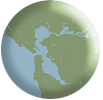The Interagency Ecological Program’s (IEP) conceptual model for the Pelagic Organism Decline (POD) recognizes that multiple factors may be acting in concert to degrade habitat and contribute to the sudden decline in native and non-native pelagic fish species (Baxter et al., 2010) in Suisun Bay and in the Delta. Factors considered include physical alterations to habitat; water withdrawals and changes in flow regime; land use changes; invasive species (including the Asian overbite clam, Potamocorbula amurensis, and multiple invasive copepods and other zooplankton); and changes in nutrient concentrations. Recent studies have argued that anthropogenic nutrient loads, in particular ammonium (NH4), play a role in ecosystem change and degradation. Dugdale et al (2007, 2012) and Parker et al. (2012a,b) make the case that elevated NH4 concentrations in Suisun and the Delta inhibit primary productivity (Dugdale et al., 2007; Parker et al., 2012a,b), and potentially contribute to low phytoplankton biomass in Suisun, with cascading effects up the food web. Elevated NH4 levels have been suggested to contribute to the increased frequency of Microcystis blooms in the Delta (Lehman et al., 2008). Changes in nutrient ratios (N:P) and forms of N have been hypothesized to be exerting additional bottom-up pressures on Delta and Suisun food webs, through influencing phytoplankton community composition and other pathways (e.g., Glibert et al., 2011).
Given the scientific and regulatory attention that issues such as elevated NH4 and shifts in N:P are receiving in Suisun Bay, and in order to resolve the differing scientific perspectives on the issues, a separate work element was created. Nutrient related issues can be divided into four broad categories: 1. NH4 inhibition of primary production; 2. NH4 toxicity to copepods (e.g., Teh et al., 2011); 3. NH4 concentration increases and N:P shifts, and effects on phytoplankton community composition and the Suisun/Delta food web; and 4. other potential causes of low primary productivity in Suisun. A detailed accounting of all relevant projects and their timelines is beyond the scope of this document, but is under development in Task 3.2.
Activities Update
Task 3.1 Field studies and experiments to assess potential impairment due to elevated ammonium or changes in N:P
A number of field and laboratory studies are underway, some affiliated with the Nutrient Strategy (e.g., Suisun/SWAMP link) or funded by the Delta Science Program or the State and Federal Contractors Water Agency (SFCWA). Other studies are currently under review, or are funded and slated to start in late 2012 or 2013. These studies will be tracked, results synthesized (Task 3.2), and where applicable conceptual models will be refined to incorporate new understanding.
|
Subtasks include:
|
Task 3.2 Synthesis of Research to Date and Suisun Ambient Water Quality Data
A series of synthesis reports will be prepared related to 1. NH4 inhibition of primary production; 2. NH4 toxicity to copepods; and 3. NH4 concentration increases and N:P shifts, and effects on phytoplankton community composition and the Suisun/Delta food web.
These reports will summarize results of peer-reviewed studies or reports from Suisun and the Delta to date, as well as relevant studies from other systems. In addition to reviewing published work, new analyses and data interpretation will be carried out, utilizing the abundant monitoring data collected by IEP/DWR and USGS, with the goal of characterizing temporal and seasonal trends, quantifying loads and internal transformations of nutrients, and using statistical tools to identify potential causal mechanisms underlying ecosystem change.
|
Subtasks include:
|
Task 3.3 Assess Science Related to Ecosystem Impacts in Suisun Bay and Relationship to Nutrients
An approach is necessary to resolve issues that have been raised relative to nutrient impacts in Suisun Bay. The strategy recommended here is to convene one or more expert panels and sponsor technical workshops to address the three broad categories of proposed nutrient-related impairment in Suisun Bay. The goals of these expert panels will include: 1. Evaluating existing scientific evidence for nutrient-related impairment in Suisun Bay; 2. Identifying areas of agreement and disagreement within the scientific literature and among the regional research community; 3. Recommending studies that can address critical conceptual gaps and data gaps. The results of these panels and the reports from Task 3.2 will be used to refine conceptual models and inform monitoring and special studies (Work Element 5) and modeling (Work element 6).
|
Subtasks include:
|
